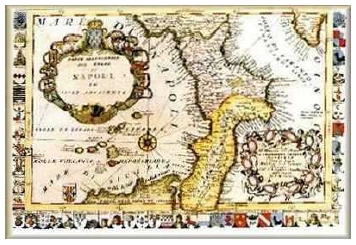|
|
 |
I PARCHI LETTERARI® IN CALABRIA “JOURNEYS TO THE FUTURE
OF MEMORY” - THE ITINERAY FOR THE JOURNEY
Calabria seems to have been
created by a fickle God, who after having made a number
of worlds, enjoyed himself by blending them all together.
(Guido Piovene)
There are a variety of possible
itineraries that can be taken in Calabria.
We shall follow those that have been outlined in the
pages of literature and which will lead us up and down
the region. Our itineraries shall be developed in four
essentially homogenous areas, in the places of literary
inspiration, where the possible themes for I Parchi
Letterari® can be developed:
 |
- the isthmus of Catanzaro;
- Sila, both large and small;
- the “Marquisate of Crotone”
- the area of Locri.
|
In these areas, there are pages and testimonies by
Cassiodorus and Costabile, Abbot Giocchino da Fiore, the
legendary Pythagoras and his disciples and the great
contemporary author Corrado Alvaro. Ancient authors from
Magna Graecia, great religious spirits from Medieval
times and the many travellers who followed them
throughout time.
The authors that have been inspired by the territory of
Calabria have been numerous and varied from the time of
ancient authors, making it is truly impossible to name
them all, however, some of them will help us to relive
the marvel of these places.
During I Parchi Letterari® “In Search of Magna Graecia”
itinerary, we shall be accompanied by an exceptional
guide, a Storyteller, a true bridge between the past and
the present, who will allow us to relive the pages
written by the travellers from both the most distant
past and more recent times.
In I Parchi Letterari® the Storyteller allows us to move
among different dimensions of time and compare the pages
taken from the literature of the past with the present.
Neither the enquiring tourist nor
the impassioned cultural aficionado will be deluded…
this type of journey, because it is an emotional one,
can be taken by anyone, as long as the traveller is
willing to be seduced and transported to other
dimensions of space and time for a while. In the end,
the “traveller” may discover that he has actually taken
a journey within himself, finding those lost echoes, and
reawakening ancient and comforting memories.
...................Let
the Journey Begin!...
...........in Calabria
"In truth, in this very fertile
and even joyous country, almost all of those things
necessary not only for the lives of mortals are born,
but also those things that exist for their delight and
pleasure as well. And this is why I said that modern day
Calabria should be included as a part of Magna Graecia;
I therefore would like to describe the praises of this
land, of what in any case belongs to it, which is
included in this name. It is this land that is almost
completely filled with mountains, and beautiful,
fruitful hills and elusive valleys. Therefore, there is
wheat, barley and other fodder, with wine of all types,
simple and other kinds, oil, figs and other flavourful
fruits, sugar, apples, wax and mineral and sea salts,
gold, silver, wool, cotton and saffron, with other
similar things. There is much silk that I dare say, when
compared to others that come from the rest of Italy (they
are similar), can be considered as equal. Here there is
flax, hemp and manna falls from the sky. Something that
is certainly rare. Near the beaches of each of the
mentioned seas, and likewise the Mediterranean, there
beautiful gardens filled with Citrons, Oranges and
Lemons of all types. There are useful rivers, the
pleasant hills of the Apennines, and dense forests of
tall oaks. There are also fertile, productive valleys of
wheat and other fodder, as I mentioned. … These places
are home to many men of great genius, and of ornate
civilised traditions, as shall be shown from place to
place".
Leandro Alberti, “A Description of the Whole of
Italy” (Bologna, 1550)
The journey begins with a welcome from the natural
surroundings that are not only beautiful, but which also
bear fruit, this is what bursts forth from the
chronicles by the first travellers.
“This magnificent province is
fertile beyond measure. Not only does all that is needed
for life grow there, but also all that is needed for
pleasure and excess […]. All of the mountains and the
valleys are useful and productive. There is a great
abundance of all types of wheat, wine and fruit, all of
the highest quality. The same can be said for the oil,
the cheeses, the sugar, the honey, the wax, the saffron,
the cotton, the anise, the coriander which is found in
great quantities, as well as the resin, the tar, the
turpentine and the snowdrop bushes. There are also gold,
silver and iron mines [.].
On the shores of both of the seas, as well as in the
hinterland, there are the most beautiful groves of
lemons, citrons and oranges of all types. The country is
rich with sources of water, both large and small, as
well as dense pine, maple, larch and oak forests in the
Apennine hills where the Agaric mushroom, white and
perfumed, grows, lighting up the night.”
Hieronymus Megiser, author of Neapolitan
Delicacies, which appeared in Leipzig in 1605.
Ancora una descrizione con accenti
enfatici. La proposizione di un Eden terrestre che in
parte contrasta con gli stereotipi e le leggende fiorite
in Europa su questa regione.
Here is yet another description with
some emphatic remarks. The portrayal of an earthly
Garden of Eden that provides a partial contrast to the
stereotypes and legends about this region that
flourished in Europe.
“The method of travel adopted by my companion and myself,
in order to allow us to write these diaries, was the
simplest and least expensive, in fact we carried out the
entire journey on foot. A horse to carry what little
baggage we had brought with us, and a guide. (…) Since
there are no hotels in those provinces, other than along
the carriage roads that run down the western coast, the
traveller must always rely upon the hospitality of a
family in each city he visits.”
(Edward Lear “Diary of a Journey on Foot in
Calabria and in the Kingdom of Naples”, Editori Riuniti
Nov.1992)
 Edward
Lear, a landscape painter, travelled through
Calabria in 1847, following the Aspromonte mountain
massif. The areas he visited are described in precious
detail in his “Travel Diary” which also includes
observations by travellers. Among Edward Lear’s pages
there is the frequent echo of the term “picturesque”
which is used to indicate landscapes and valleys that
remind him of Ann Radcliffe, and the customs of daily
life, which are objects of attention for travellers and
artists. Edward
Lear, a landscape painter, travelled through
Calabria in 1847, following the Aspromonte mountain
massif. The areas he visited are described in precious
detail in his “Travel Diary” which also includes
observations by travellers. Among Edward Lear’s pages
there is the frequent echo of the term “picturesque”
which is used to indicate landscapes and valleys that
remind him of Ann Radcliffe, and the customs of daily
life, which are objects of attention for travellers and
artists.
"Calabria! This harmonious name, has an element of
romance. No other region of the Neapolitan kingdom
includes the promise of such a number of surprising and
beautiful elements. As soon as this name is pronounced,
a new world emerges in front of our eyes, opening up
spacious horizons to the imagination: streams,
fortresses, scenes of mountain cliffs high above smooth,
white beaches, caves, brigands, pointed hats – Mrs
Radcliffe and Salvator Rosa -, customs, traditions,
atrocities and never-ending beauty". (Lear, 9).
And another of the main elements that
stands out during a journey through Calabria emerges, in
other words, the hospitality of its people.
"But the feature that continues to emerge is that of
the hospitality that has no common place.”
"Nothing could have been more kindly and well mannered
than the cordial welcome given to us by this family… But
the desire to welcome us, which we noticed is common
throughout all of Calabria, was demonstrated perfectly
by the surprising appearance of maccheroni, eggs, olives,
butter, cheese, and naturally wine and snow on the table
that was set with the whitest of linen tablecloths..."
All in all a good viaticum to enjoy the beauty of the
places that will also follow for many other travellers
and writers. Among these is Norman Douglas who
with his Old Calabria of 1915, penned the famous pages
that describe the nature and the customs of the region.
“It was a splendid journey crossing those plateaus,
with the view of the Ionian Sea from high above and the
panorama of the wide Crati valley and from the high
chain of the Pollino mountains, covered in the haze of
early autumn, with the view falling upon the sides of
the hills covered in olive trees. The road winds around
the cliffs, where the streams come down from the
mountain; they are covered in cork oak trees, live oaks
and other vegetation; Golden Orioles, Jays , Hoopoe and
other coraciform bird species can be found among the
tree branches. During the winter, the cold winds from
the Apennines blow through these mountains, but during
this season, the area is stupendous.”
Anyone travelling in Calabria will discover the
surprising and ever-changing corners of nature and
culture found in this area. It is a genuine
“labyrinth” of emotions...
“Travelling in Calabria means continual comings and
goings, just as if one were to follow the winding route
of a labyrinth. Interrupted by steep streams, not just
different from area to area, but changing with brusque
passages of the landscape, the climate and the ethnic
origins of the inhabitants. It is certainly the most
peculiar of our regions. In its vast mountain plains, it
sometimes resembles Switzerland, the Alto Adige or
Scandinavian countries rather than Southern Italy. Then,
from this imaginary northern region it transforms into
olive groves along the coast that are typical of the
Mediterranean region. Canyons that are reminiscent of
the United States infiltrate the region, as well as
tracts of African deserts and some areas where the
buildings preserve Byzantine memories...”
G. Piovene, A Journey Through Italy, 1957, p. 659
More recent travellers provide us with a description of
places that gradually become more similar to those that
are still visible to us today.
Luigi Vittorio Bertarelli, the head of the
Italian Bicycle Touring Club, later known as TCI, (Calabria
and Basilicata, five days of bicycle excursions,
1897) needed to provide an overview of the region from
the viewpoint of a modern traveller for the first
Italian Touring Guide of Calabria. He departed by train
from Milan and reached the city of Reggio Calabria after
a journey of 1,400 kilometres; he then got on a bicycle
and headed north. In Villa San Giovanni he encountered
another cyclist: the only one until he arrived in
Salerno.
“There were a number of small fishing and cabotage
boats, nets, winches to tow the boats ashore, small
shipyards for caulkers, wash houses, a few rudimentary
beach huts, financiers’ sentry boxes, rowdy groups of
bare-legged, boys and girls, angling for fish and
gathering seafood: a beach buzzing with life, just like
in Liguria.”
Bertarelli saw orange, citron, bergamot and lemon groves
along a crystalline sea marked by a line of sea foam.
The dusty road was bordered by Mimosa bushes and
blooming Broom shrubs. He quenched his thirst at a pure
spring, hidden in a wood, sipping the water surrounded
by water lilies and lotus flowers.
"However, Calabria still remains the land of
“incredible, stupendous landscapes, with resolute
patriarchal traditions, and the warm humanity of its
inhabitants,” as affirmed yet again by Gerhard
Rolfhs in the mid 18th Century.
Now the journey continues, with some of the itineraries
to the places…of I Parchi
Letterari® in Calabria.
|



